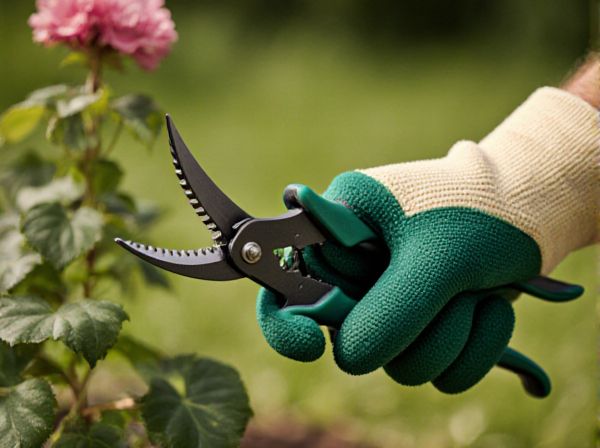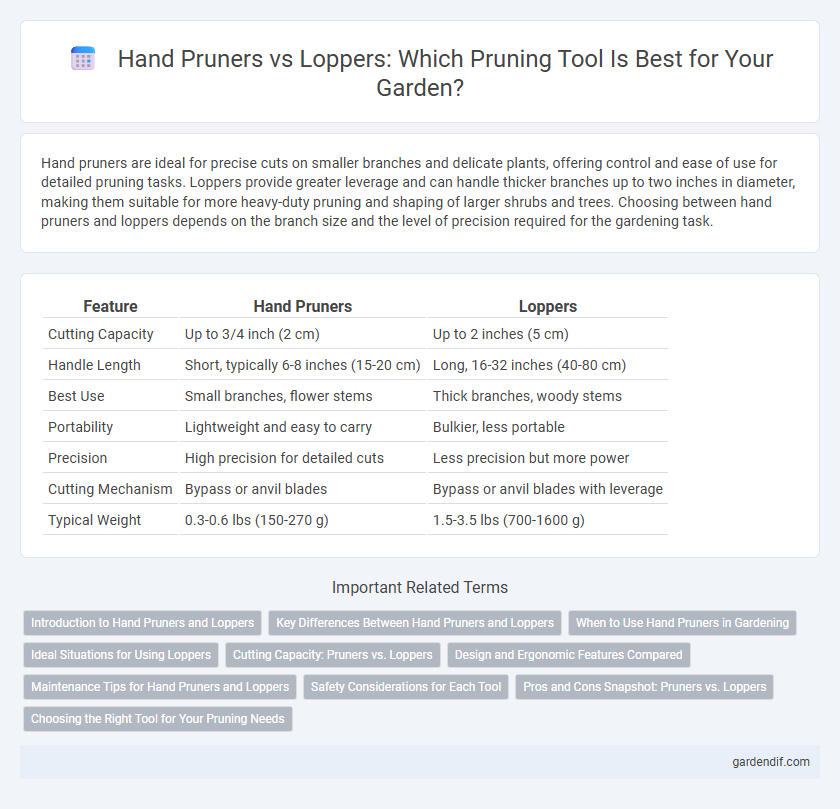
Hand pruners vs Loppers Illustration
Hand pruners are ideal for precise cuts on smaller branches and delicate plants, offering control and ease of use for detailed pruning tasks. Loppers provide greater leverage and can handle thicker branches up to two inches in diameter, making them suitable for more heavy-duty pruning and shaping of larger shrubs and trees. Choosing between hand pruners and loppers depends on the branch size and the level of precision required for the gardening task.
Table of Comparison
| Feature | Hand Pruners | Loppers |
|---|---|---|
| Cutting Capacity | Up to 3/4 inch (2 cm) | Up to 2 inches (5 cm) |
| Handle Length | Short, typically 6-8 inches (15-20 cm) | Long, 16-32 inches (40-80 cm) |
| Best Use | Small branches, flower stems | Thick branches, woody stems |
| Portability | Lightweight and easy to carry | Bulkier, less portable |
| Precision | High precision for detailed cuts | Less precision but more power |
| Cutting Mechanism | Bypass or anvil blades | Bypass or anvil blades with leverage |
| Typical Weight | 0.3-0.6 lbs (150-270 g) | 1.5-3.5 lbs (700-1600 g) |
Introduction to Hand Pruners and Loppers
Hand pruners, also known as secateurs, are compact gardening tools designed for precise cutting of small branches and stems up to 3/4 inch thick. Loppers feature long handles and powerful blades, enabling the cutting of thicker branches up to 2 inches in diameter with increased leverage and reduced effort. Both tools are essential for pruning tasks, with hand pruners excelling in detailed trimming and loppers suited for heavier pruning needs.
Key Differences Between Hand Pruners and Loppers
Hand pruners offer precision cutting for branches up to 3/4 inch in diameter, making them ideal for detailed trimming and shaping of shrubs and small plants. Loppers, with longer handles and greater leverage, efficiently cut through thicker branches ranging from 1 to 2 inches, enabling gardeners to manage larger limbs and enhance overall plant health. The ergonomic design difference between the compact hand pruner and the extended-reach lopper determines their specific uses in pruning tasks and affects user fatigue during prolonged gardening sessions.
When to Use Hand Pruners in Gardening
Hand pruners are ideal for precise cutting of branches up to 3/4 inch thick, making them perfect for detailed tasks such as deadheading flowers, trimming small stems, and shaping shrubs. Their ergonomic design allows for easy maneuverability in tight spaces where larger tools like loppers cannot reach. Use hand pruners during regular garden maintenance to promote healthy plant growth by removing diseased or damaged foliage with minimal disruption.
Ideal Situations for Using Loppers
Loppers excel in cutting thick branches typically measuring 1 to 2 inches in diameter, making them ideal for pruning mature shrubs and small trees where precision and leverage are required. Their long handles provide enhanced reach and greater cutting power, allowing gardeners to manage dense or overgrown plants without the need for a ladder. Optimal use of loppers includes clearing out woody stems and shaping large perennial plants, ensuring clean cuts that promote healthy regrowth.
Cutting Capacity: Pruners vs. Loppers
Hand pruners typically offer a cutting capacity of up to 3/4 inch in diameter, making them ideal for trimming small branches and stems. Loppers provide a larger cutting capacity, often ranging from 1 to 2 inches, allowing for the removal of thicker branches and more substantial pruning tasks. Choosing between pruners and loppers depends on the branch size and the precision required for the pruning job.
Design and Ergonomic Features Compared
Hand pruners feature compact, lightweight designs with cushioned handles that reduce hand fatigue, making them ideal for precise cuts on small branches and stems. Loppers have longer handles and a heavy-duty construction, providing greater leverage and reach for cutting thicker branches up to 2 inches in diameter. Ergonomic grips on both tools enhance comfort, but loppers often include ratcheting mechanisms or gear systems to minimize user effort during extended pruning tasks.
Maintenance Tips for Hand Pruners and Loppers
Hand pruners and loppers require regular maintenance to ensure clean cuts and prolong tool life, including sharpening blades with a fine file or sharpening stone to maintain a precise edge. Keeping pivot bolts tight and lubricating moving parts with lightweight oil prevents rust and ensures smooth operation. Cleaning blades after each use with a cloth and mild soapy water removes sap and debris, reducing corrosion and improving cutting efficiency.
Safety Considerations for Each Tool
Hand pruners feature a compact design that allows precise cuts with minimal force, reducing the risk of strain or slipping injuries during detailed pruning tasks. Loppers, with their extended handles, provide greater leverage for cutting thicker branches but require careful handling to avoid overexertion and potential loss of control, which can lead to accidents. Both tools necessitate sharp blades and secure grips, with hand pruners benefiting from safety locks to prevent accidental openings and loppers requiring a firm, two-handed grip to ensure balanced, controlled cuts.
Pros and Cons Snapshot: Pruners vs. Loppers
Hand pruners offer precision cutting ideal for small branches up to 3/4 inch, providing ease of use and maneuverability in tight spaces but require more effort for thicker branches. Loppers can tackle branches up to 2 inches in diameter with longer handles that provide greater leverage, reducing hand strain but may be less effective for intricate cuts or pruning in confined areas. Choosing between hand pruners and loppers depends on branch thickness, reach needed, and desired control during pruning tasks.
Choosing the Right Tool for Your Pruning Needs
Hand pruners are ideal for cutting branches up to 3/4 inch thick, providing precision for detailed trimming and shaping. Loppers handle larger branches up to 1-2 inches in diameter, offering greater leverage and reach for heavier cuts. Selecting between hand pruners and loppers depends on branch size, accessibility, and the specific pruning task to ensure efficient and clean cuts.
Hand pruners vs Loppers Infographic

 gardendif.com
gardendif.com